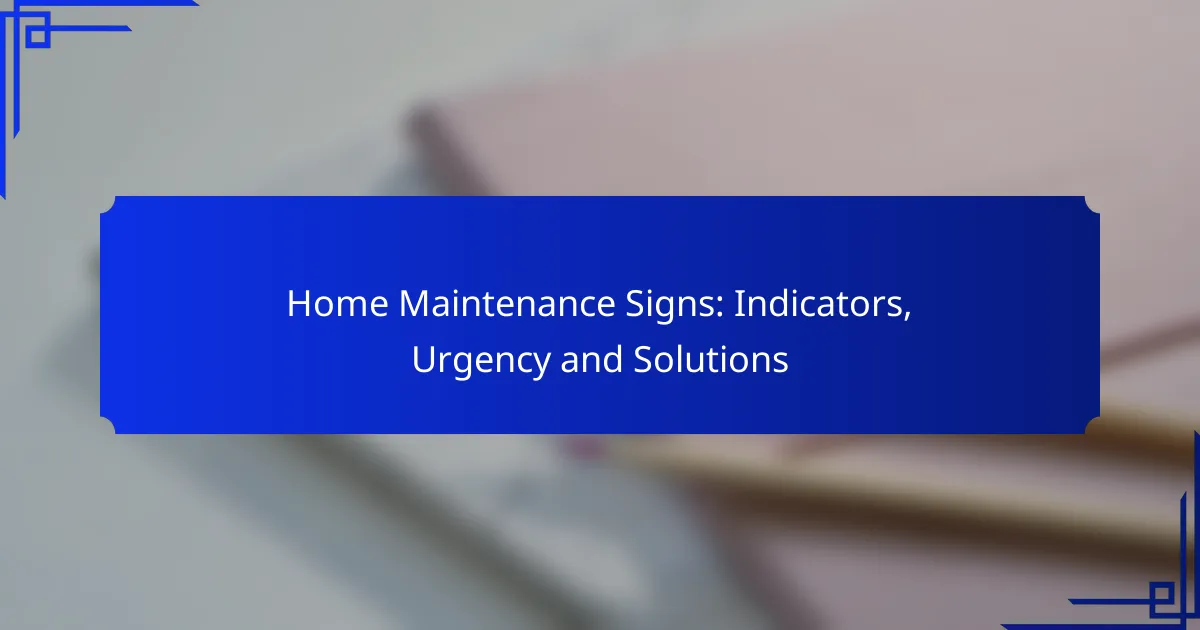Home maintenance signs are crucial indicators of potential issues that can lead to costly repairs if left unaddressed. By recognizing these signs early, homeowners can take proactive measures to prevent further damage and ensure the safety and integrity of their living spaces.
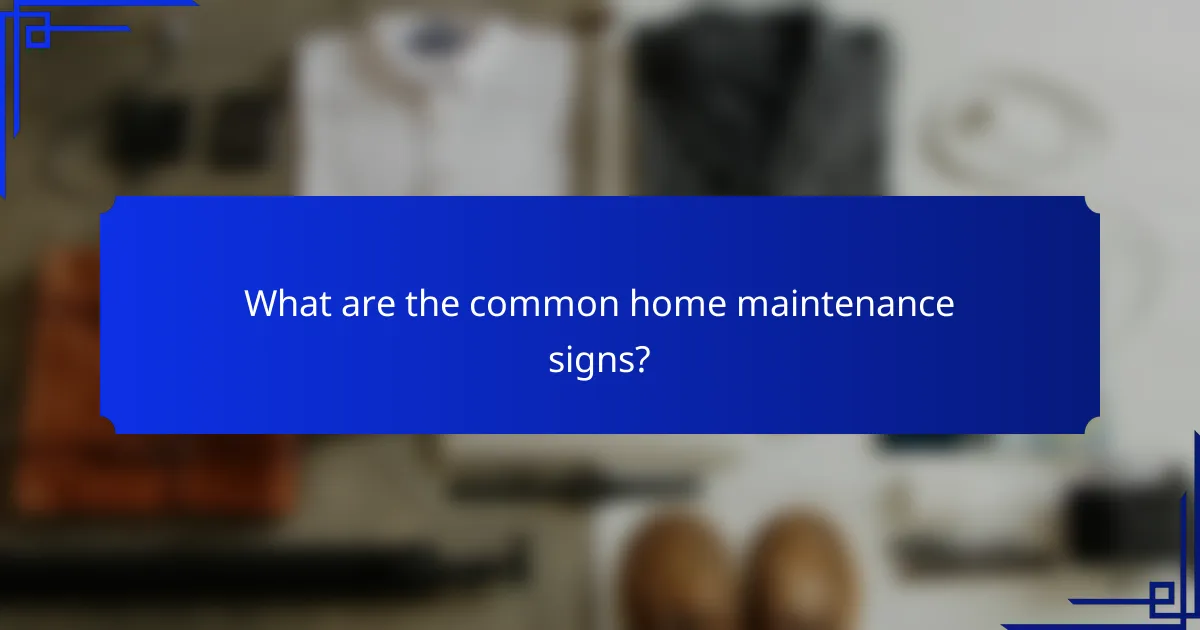
What are the common home maintenance signs?
Common home maintenance signs indicate potential issues that require attention to prevent further damage. Recognizing these signs early can save homeowners time and money by addressing problems before they escalate.
Leaky faucets
Leaky faucets are a frequent home maintenance issue that can lead to increased water bills and water damage. A dripping faucet can waste several gallons of water daily, so it’s essential to address it promptly.
To fix a leaky faucet, start by identifying the type of faucet you have—compression, cartridge, ball, or ceramic disk. Often, replacing a worn washer or O-ring can resolve the issue. If you’re unsure, consulting a plumber may be beneficial.
Cracked walls
Cracked walls can indicate structural issues or settling in your home. Small hairline cracks are often normal, but larger cracks may suggest more serious problems that require immediate attention.
Inspect cracks for width and length. If they exceed a quarter-inch in width or are accompanied by other signs like doors that stick, consider hiring a structural engineer for an evaluation. Repairing cracks early can prevent costly repairs down the line.
Roof stains
Roof stains, particularly dark streaks or discoloration, can signal algae growth or moisture retention, which may lead to roof deterioration. Regular inspections can help identify these stains before they cause significant damage.
To address roof stains, consider cleaning the roof with a mixture of water and bleach or hiring a professional service. It’s also wise to check for proper drainage and ventilation to prevent future issues.
Unusual odors
Unusual odors in your home can indicate various problems, including mold growth, plumbing leaks, or electrical issues. Identifying the source of these odors is crucial for maintaining a healthy living environment.
Start by locating the source of the smell. If it resembles mildew, check for water damage or leaks. If it’s a burning smell, turn off electrical appliances and consult an electrician immediately. Addressing odors promptly can prevent health risks and further damage.
Heating/cooling issues
Heating and cooling issues can manifest as inconsistent temperatures or unusual noises from HVAC systems. These problems can lead to discomfort and increased energy costs if not resolved quickly.
Regular maintenance, such as changing filters and scheduling annual inspections, can help prevent these issues. If your system is more than a decade old and frequently malfunctions, consider evaluating replacement options for improved efficiency and comfort.
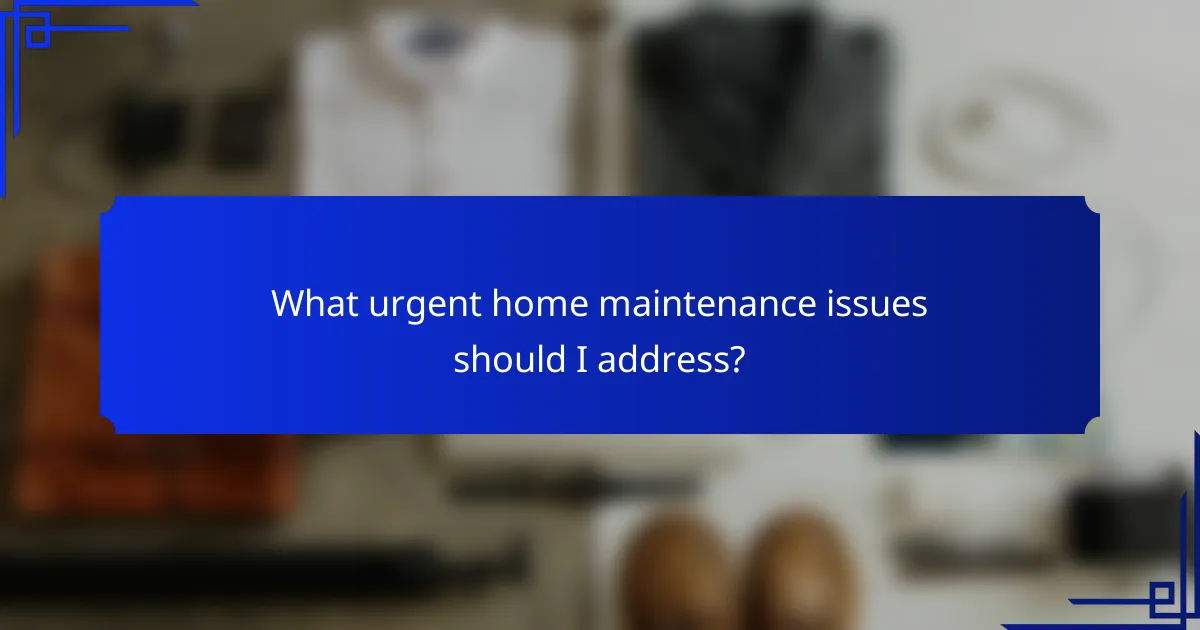
What urgent home maintenance issues should I address?
Urgent home maintenance issues require immediate attention to prevent further damage and costly repairs. Key areas to monitor include water damage, electrical problems, and structural damage, as these can pose safety risks and affect the integrity of your home.
Water damage
Water damage can occur from leaks, flooding, or condensation and can lead to mold growth and structural issues. Check for signs such as discoloration on walls or ceilings, musty odors, and damp spots. Addressing water damage quickly can save thousands in repairs and health risks.
To mitigate water damage, inspect plumbing fixtures regularly and ensure proper drainage around your home. If you notice significant leaks or pooling water, consider contacting a professional to assess the situation and recommend repairs.
Electrical problems
Electrical problems can manifest as flickering lights, tripped circuit breakers, or outlets that do not work. These issues can indicate faulty wiring or overloaded circuits, which pose fire hazards. If you experience persistent electrical issues, it is crucial to address them immediately.
To ensure safety, avoid overloading outlets and use surge protectors for sensitive electronics. If you are unsure about the cause of electrical problems, hire a licensed electrician to evaluate your system and make necessary repairs.
Structural damage
Structural damage can include cracks in walls, uneven floors, or doors that do not close properly. These signs may indicate foundational issues that require prompt attention to prevent further deterioration. Ignoring structural problems can lead to extensive repairs and safety concerns.
Regularly inspect your home for signs of structural damage, especially after severe weather. If you notice significant cracks or shifting, consult a structural engineer to assess the damage and recommend appropriate solutions.

How can I fix leaky faucets?
Fixing leaky faucets typically involves identifying the source of the leak and applying the appropriate solution. Common methods include replacing washers, installing a new faucet, or checking water pressure.
Replace washers
Replacing washers is often the first step in fixing a leaky faucet. Washers can wear out over time, leading to leaks. To replace a washer, turn off the water supply, disassemble the faucet, remove the old washer, and install a new one that matches the size and type.
Make sure to use washers made from durable materials, such as rubber or silicone, which can withstand water pressure and temperature changes. This simple fix can often resolve leaks without the need for more extensive repairs.
Install new faucet
If replacing washers does not solve the leak, installing a new faucet may be necessary. Choose a faucet that fits your sink and meets your style preferences. Ensure that the new faucet is compatible with your existing plumbing to avoid additional modifications.
When installing a new faucet, follow the manufacturer’s instructions carefully. This typically involves removing the old faucet, cleaning the sink surface, and securing the new faucet in place. Proper installation can prevent future leaks and improve water efficiency.
Check water pressure
High water pressure can cause faucets to leak, so checking the water pressure is essential. Ideal residential water pressure is usually between 40 and 60 psi. If your pressure exceeds this range, it may be necessary to install a pressure regulator.
To check the water pressure, you can use a pressure gauge attached to a faucet. If the pressure is too high, consider contacting a plumber to adjust the pressure or install a regulator. Managing water pressure can help prolong the life of your faucets and prevent leaks.

What are the signs of roof damage?
Signs of roof damage can manifest in various ways, indicating the need for inspection or repair. Common indicators include missing shingles, granule loss, and water stains on ceilings, each of which can lead to more significant issues if not addressed promptly.
Missing shingles
Missing shingles are a clear sign of potential roof damage. They can occur due to severe weather, age, or poor installation. If you notice any gaps where shingles should be, it’s essential to replace them quickly to prevent water infiltration.
To check for missing shingles, inspect your roof from the ground or use binoculars. Look for any areas where the roof surface appears uneven or bare. If you find missing shingles, consider hiring a professional to assess the situation and perform repairs.
Granule loss
Granule loss refers to the shedding of the protective granules on asphalt shingles, which can expose the underlying material to damage. This can happen due to age, weather conditions, or poor-quality shingles. If you notice granules in your gutters or on the ground, it’s a sign that your roof may be deteriorating.
Regularly inspect your roof for granule loss, especially after heavy rain or wind. If you observe significant granule loss, consult a roofing expert to determine whether a roof replacement is necessary or if repairs can extend its life.
Water stains on ceilings
Water stains on ceilings often indicate a leak in the roof, which can lead to serious structural damage if not addressed. These stains typically appear as brown or yellow discolorations and may expand over time. Identifying the source of the leak is crucial for effective repairs.
To address water stains, first, locate the source of the leak, which may involve inspecting the roof and attic. Once identified, repair the roof and consider repainting the stained area after it has dried. If the damage is extensive, consult a professional to evaluate the roof’s integrity and recommend appropriate solutions.
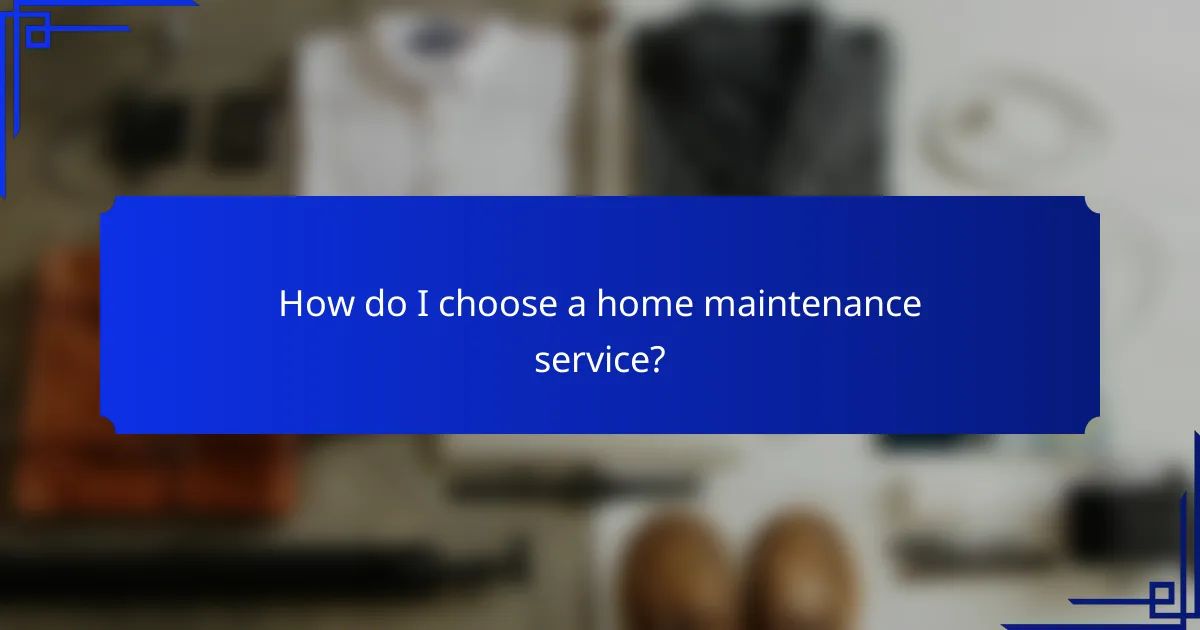
How do I choose a home maintenance service?
Choosing a home maintenance service involves evaluating their reputation, verifying their credentials, and comparing costs. Focus on finding a reliable provider that meets your specific needs and budget.
Check reviews
Start by looking for customer reviews on platforms like Google, Yelp, or local service directories. Positive feedback from previous clients can indicate a trustworthy service, while consistent negative reviews may signal potential issues.
Consider the volume of reviews as well; a service with many positive reviews is often more reliable than one with just a few. Pay attention to recent reviews to gauge the current quality of their work.
Verify licenses
Ensure that the home maintenance service holds the necessary licenses and certifications required in your area. This may include general contractor licenses, insurance, and specific trade certifications.
Licensing not only demonstrates professionalism but also compliance with local regulations. You can typically verify a service’s credentials through state or local government websites.
Request quotes
Requesting quotes from multiple home maintenance services allows you to compare pricing and services offered. Be clear about the specific work you need done to receive accurate estimates.
When reviewing quotes, consider not just the price but also the scope of work included. A slightly higher quote may cover more comprehensive services or better materials, making it a better value in the long run.
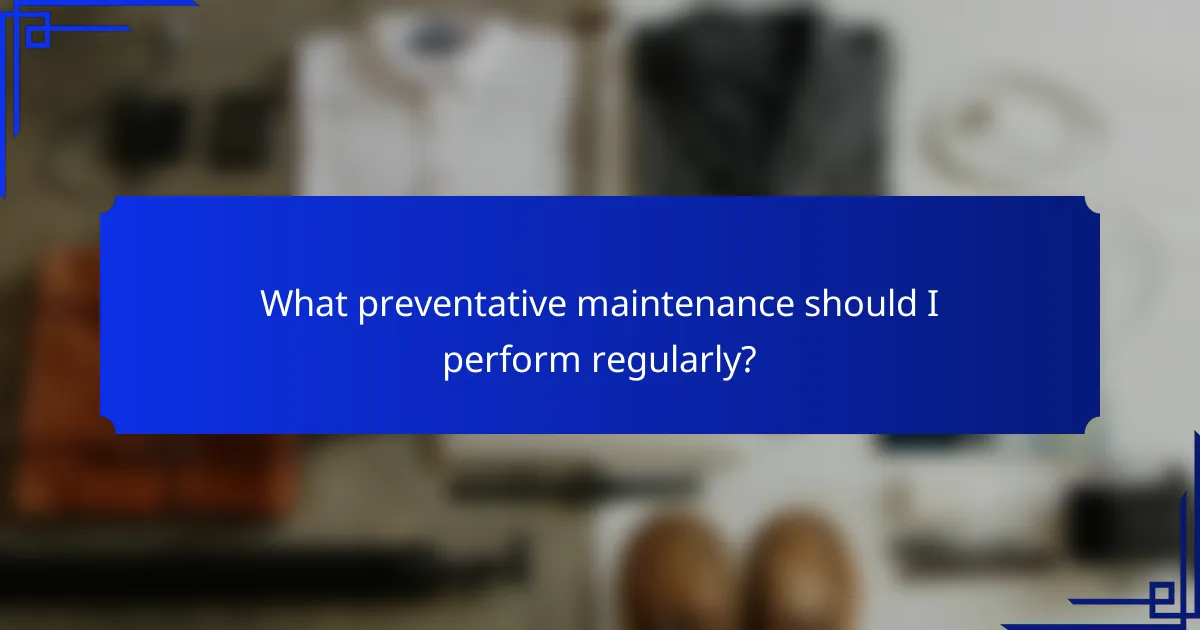
What preventative maintenance should I perform regularly?
Regular preventative maintenance is essential for keeping your home in good condition and avoiding costly repairs. Key tasks include inspecting systems and components, cleaning, and making minor repairs to ensure everything functions efficiently.
Inspect your roof and gutters
Regularly inspecting your roof and gutters helps prevent water damage and extends the lifespan of these components. Look for missing shingles, signs of wear, or debris buildup in gutters that can cause blockages.
Consider performing these inspections at least twice a year, ideally in spring and fall. If you notice any issues, such as leaks or sagging, address them promptly to avoid more extensive damage.
Check HVAC systems
Checking your heating, ventilation, and air conditioning (HVAC) systems is crucial for maintaining indoor comfort and efficiency. Change air filters every 1-3 months and schedule professional maintenance annually to ensure optimal performance.
Pay attention to unusual noises or reduced airflow, as these can indicate problems. Regular maintenance can help avoid costly repairs and extend the life of your HVAC system.
Test smoke and carbon monoxide detectors
Testing smoke and carbon monoxide detectors is vital for safety. Check these devices monthly to ensure they are functioning correctly, replacing batteries as needed.
Replace detectors every 10 years or according to manufacturer recommendations. Having working detectors can save lives and reduce the risk of fire or carbon monoxide poisoning.
Maintain plumbing systems
Regular plumbing maintenance can prevent leaks and water damage. Inspect pipes for signs of corrosion or leaks, and check faucets and toilets for drips or running water.
Consider flushing your water heater annually to remove sediment buildup, which can improve efficiency. Addressing small leaks promptly can prevent larger issues and save on water bills.
Service appliances
Servicing household appliances helps maintain their efficiency and longevity. Clean refrigerator coils, check washing machine hoses for wear, and ensure that dryer vents are clear of lint.
Follow manufacturer guidelines for regular maintenance and consider scheduling professional servicing for complex appliances. Keeping appliances in good condition can reduce energy costs and prevent breakdowns.
